Name Marina Abramovic | ||
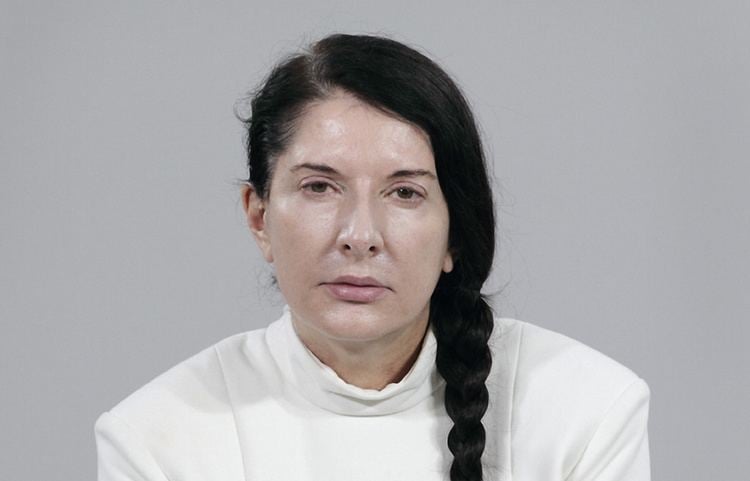 | ||
Notable work Rhythm Series (1973–1974)Works with Ulay (1976–1988)Balkan Baroque (1997)The Artist is Present (2010) Website "http://www.marinaabramovic.com""http://www.mai-hudson.org" Spouse Paolo Canevari (m. 2005–2009), Nesa Paripovic (m. 1971–1976) Books Balkan Epic, Abramovic, 7 easy pieces, Akademie X: Lessons in Art + Life, Student Body, Marina Abramovic Institute Parents Vojo Abramovic, Danica Abramovic Movies Bob Wilson\'s Life & De, Stories on Human Rights, !Women Art Revolution, Antony and the Johnsons, Dangerous Games Similar People Ulay, Paolo Canevari, Nesa Paripovic, Klaus Biesenbach, Gina Pane Profiles | ||
Marina Abramović: What is Performance Art?
Marina Abramović (Serbian Cyrillic: Марина Абрамовић, [maˌrǐːna abˈrǎːmoʋit͡ɕ]; born November 30, 1946) is a Yugoslavia-born performance artist. Her work explores the relationship between performer and audience, the limits of the body, and the possibilities of the mind. Active for over three decades, Abramović has been described as the "grandmother of performance art." She pioneered a new notion of identity by bringing in the participation of observers, focusing on "confronting pain, blood, and physical limits of the body."
Contents
- Marina Abramovi What is Performance Art
- Body of Art Meet performance artist Marina Abramovic
- Early life education and teaching
- Rhythm 10 1973
- Rhythm 5 1974
- Rhythm 2 1974
- Rhythm 4 1974
- Rhythm 0 1974
- Cleaning The Mirror 1995
- Spirit Cooking 1996
- Works with Ulay Uwe Laysiepen
- Seven Easy Pieces 2005
- The Artist Is Present March May 2010
- Other
- Collaborations
- Controversy
- Films
- Awards
- Marina Abramovi Institute
- Criticism
- References
Body of Art: Meet performance artist Marina Abramovic
Early life, education and teaching
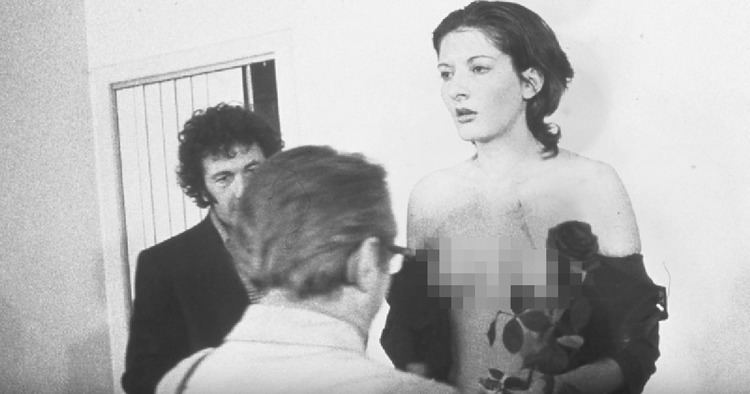
Abramović was born in Belgrade, Yugoslavia on November 30, 1946. Her great uncle was Serbian Patriarch Varnava of the Serbian Orthodox Church. Both of her parents were Yugoslav Partisans during the Second World War. Her mother was Danica Rosić and her father was Vojin Abramović. After the war, Abramović's parents were "national heroes" and were given positions in the post-war Yugoslavian government. In an interview, Abramović described her family as having been "Red bourgeoisie."
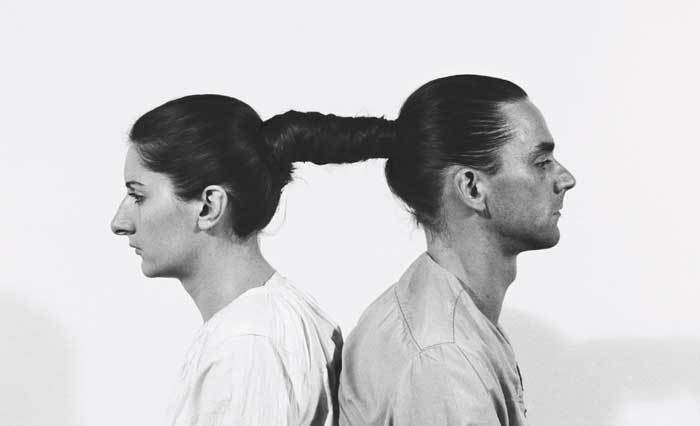
Until she was six years old, Abramović was raised by her grandparents. Her grandmother was deeply religious and Abramović "spent my childhood in a church following my grandmother's rituals – candles in the morning, the priest coming for different occasions." At age six, when Abramović's brother was born, she began living with her parents and took piano, French, and English lessons. While she did not take art lessons, she took an early interest in art and enjoyed painting as a child.
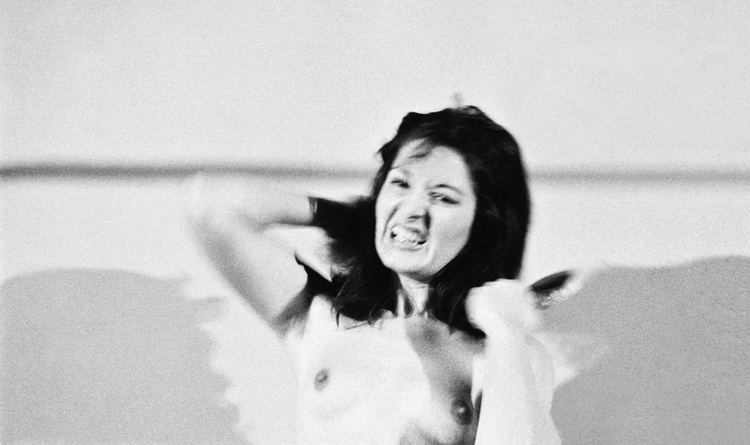
As a child, Abramović's mother beat her. In an interview published in 1998, Abramović described how her "mother took complete military-style control of me and my brother. I was not allowed to leave the house after 10 o'clock at night till I was 29 years old. ... [A]ll the performances in Yugoslavia I did before 10 o'clock in the evening because I had to be home then. It's completely insane, but all of my cutting myself, whipping myself, burning myself, almost losing my life in the firestar, everything was done before 10 in the evening."
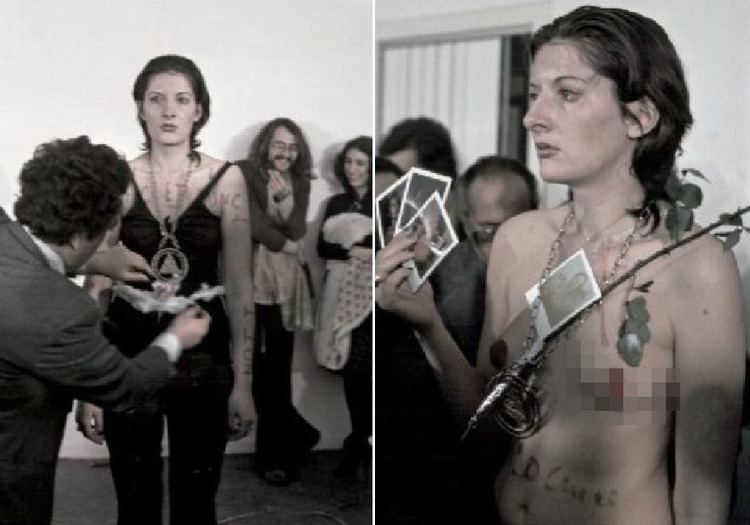
In an interview published in 2013, Abramović said, "My mother and father had a terrible marriage." Describing an incident when her father smashed 12 champagne glasses and left the house, she said, "It was the most horrible moment of my childhood."
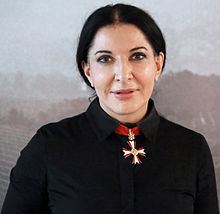
She was a student at the Academy of Fine Arts in Belgrade from 1965 to 1970. She completed her post-graduate studies at the Academy of Fine Arts in Zagreb, SR Croatia in 1972. From 1973 to 1975, she taught at the Academy of Fine Arts at Novi Sad, while implementing her first solo performances.
From 1971 to 1976, she was married to Neša Paripović. In 1976, she went to Amsterdam to perform a piece (later claiming on the day of her birthday) then decided to move there permanently.
1990–1991 Abramović was a visiting professor at the Académie des Beaux-Arts in Paris and at the Berlin University of the Arts. 1992–1996 she was a visiting professor at the Hochschule für bildende Künste Hamburg and 1997–2004 she was a professor for performance-art at the Hochschule für bildende Künste Braunschweig. Her best known students are Sebastian Bieniek and Chiharu Shiota.
Rhythm 10, 1973
In her first performance in Edinburgh 1973, Abramović explored elements of ritual and gesture. Making use of twenty knives and two tape recorders, the artist played the Russian game, in which rhythmic knife jabs are aimed between the splayed fingers of one's hand. Each time she cut herself, she would pick up a new knife from the row of twenty she had set up, and record the operation. After cutting herself twenty times, she replayed the tape, listened to the sounds, and tried to repeat the same movements, attempting to replicate the mistakes, merging past and present. She set out to explore the physical and mental limitations of the body – the pain and the sounds of the stabbing; the double sounds from the history and the replication. With this piece, Abramović began to consider the state of consciousness of the performer. "Once you enter into the performance state you can push your body to do things you absolutely could never normally do."
Rhythm 5, 1974
In this performance, Abramović sought to re-evoke the energy of extreme bodily pain, using a large petroleum-drenched star, which the artist lit on fire at the start of the performance. Standing outside the star, Abramović cut her nails, toenails, and hair. When finished with each, she threw the clippings into the flames, creating a burst of light each time. Burning the communist five-pointed star represented a physical and mental purification, while also addressing the political traditions of her past. In the final act of purification, Abramović leapt across the flames, propelling herself into the center of the large star. Due to the light and smoke given off by the fire, the observing audience did not realize that, once inside the star, the artist had lost consciousness from lack of oxygen. Some members of the audience realized what had occurred only when the flames came very near to her body and she remained inert. A doctor and several members of the audience intervened and extricated her from the star.
Abramović later commented upon this experience: "I was very angry because I understood there is a physical limit: when you lose consciousness you can't be present; you can't perform."
Rhythm 2, 1974
Prompted by her loss of consciousness during Rhythm 5, Abramović devised the two-part Rhythm 2 to incorporate a state of unconsciousness in a performance. She performed the work at the Gallery of Contemporary Art in Zagreb, in 1974. In Part I, which had a duration of 50 minutes, she ingested a medication she describes as 'given to patients who suffer from catatonia to force them to change the positions of their bodies'. The medication caused her muscles to contract violently, and she lost complete control over her body, while remaining aware of what was going on. After a ten-minute break, she took a second medication 'given to schizophrenic patients with violent behavior disorders to calm them down'. The performance ended when the medication wore off after six hours.
Rhythm 4, 1974
In this piece, Abramović kneeled alone and naked in a room with a high-power industrial fan. She approached the fan slowly, attempting to breath in as much air as possible to push the limits of her lungs. Soon after she lost consciousness.
Rhythm 0, 1974
To test the limits of the relationship between performer and audience, Abramović developed one of her most challenging (and best-known) performances. She assigned a passive role to herself, with the public being the force which would act on her. Abramović placed on a table 72 objects that people were allowed to use (a sign informed them) in any way that they chose. Some of these were objects that could give pleasure, while others could be wielded to inflict pain, or to harm her. Among them were a rose, a feather, honey, a whip, olive oil, scissors, a scalpel, a gun and a single bullet. For six hours the artist allowed the audience members to manipulate her body and actions. This tested how vulnerable and aggressive the human subject could be when hidden from social consequences. By the end of the performance, her body was stripped, attacked, and devalued into an image that Abramović described as the "Madonna, mother, and whore". Additionally, markings of aggression were apparent on the artist's body. There were cuts on her neck made by audience members, and her clothes were cut off of her body.
In her works, Abramović affirms her identity through the perspective of others, however, more importantly by changing the roles of each player, the identity and nature of humanity at large is unraveled and showcased. By doing so, the individual experience morphs into a collective one and creates a powerful message. Abramović's art also represents the objectification of the female body, as she remains motionless and allows the spectators to do as they please with her body, pushing the limits of what one would consider acceptable. This type representation also reflects key political issues such as BDSM, which complicates and questions the relation between art versus sexuality and public discourse.
Initially, members of the audience reacted with caution and modesty, but as time passed (and the artist remained passive) people began to act more aggressively. As Abramović described it later: "What I learned was that ... if you leave it up to the audience, they can kill you. ... I felt really violated: they cut up my clothes, stuck rose thorns in my stomach, one person aimed the gun at my head, and another took it away. It created an aggressive atmosphere. After exactly 6 hours, as planned, I stood up and started walking toward the audience. Everyone ran away, to escape an actual confrontation."
Cleaning The Mirror, 1995
Cleaning the Mirror consisted of five monitors playing footage in which Abramović scrubs a grimy human skeleton in her lap. She vigorously brushes the different parts of the skeleton with soapy water. Each monitor is dedicated to one part of the skeleton: the head, the pelvis, the ribs, the hands, and the feet. Each video is filmed with its own sound, creating an overlap. As the skeleton becomes cleaner, Abramović becomes covered in the grayish dirt that was once covering the skeleton. This three-hour performance is filled with metaphors of the Tibetan death rites that prepare disciples to become one with their own mortality. The piece is a part of a three-piece series. Cleaning the Mirror #1 was performed at the Museum of Modern Art consisting of three hours. Cleaning the Mirror #2 consisted of 90 minutes performed at Oxford University. Cleaning the Mirror #3 was performed at Pitt Rivers Museum for five hours.
Spirit Cooking, 1996
Abramović worked with Jacob Samuel to produce a cookbook of "aphrodisiac recipes" called Spirit Cooking in 1996, These "recipes" were meant to be "evocative instructions for actions or for thoughts." For example, one of the recipes calls for "13,000 grams of jealousy," while another says to "mix fresh breast milk with fresh sperm milk." The work was inspired by the popular belief that ghosts feed off intangible things like light, sound, and emotions.
In 1997, Abramović created a multimedia Spirit Cooking installation. This was originally installed in the Zerynthia Associazione per l'Arte Contemporanea in Rome, Italy and included white gallery walls with "enigmatically violent recipe instructions" painted in pig's blood. According to Alexxa Gotthardt, the work is "a comment on humanity's reliance on ritual to organize and legitimize our lives and contain our bodies."
Works with Ulay (Uwe Laysiepen)
In 1976, after moving to Amsterdam, Abramović met the West German performance artist Uwe Laysiepen, who went by the single name Ulay. When Abramović and Ulay began their collaboration, the main concepts they explored were the ego and artistic identity. This was the beginning of a decade of influential collaborative work. Each performer was interested in the traditions of their cultural heritages and the individual's desire for ritual. Consequently, they decided to form a collective being called "The Other", and spoke of themselves as parts of a "two-headed body". They dressed and behaved like twins and created a relationship of complete trust. As they defined this phantom identity, their individual identities became less accessible. In an analysis of phantom artistic identities, Charles Green has noted that this allowed a deeper understanding of the artist as performer, for it revealed a way of "having the artistic self made available for self-scrutiny."
While some critics have explored the idea of a hermaphroditic state of being as a feminist statement, Abramović herself denies considering this as a conscious concept. Her body studies, she insists, have always been concerned primarily with the body as the unit of an individual, a tendency she traces to her parents' military pasts. Rather than concerning themselves with gender ideologies, Abramović/Ulay explored extreme states of consciousness and their relationship to architectural space. They devised a series of works in which their bodies created additional spaces for audience interaction. In discussing this phase of her performance history, she has said: "The main problem in this relationship was what to do with the two artists' egos. I had to find out how to put my ego down, as did he, to create something like a hermaphroditic state of being that we called the death self."
Between 1981 and 1987, the pair performed "Nightsea Crossing" in twenty-two performances. They sat silently across from each other in chairs for seven hours a day.
In 1988, after several years of tense relations, Abramović and Ulay decided to make a spiritual journey which would end their relationship. They each walked the Great Wall of China, in a piece called The Great Wall Walk, starting from the two opposite ends and meeting in the middle. As Abramović described it: "That walk became a complete personal drama. Ulay started from the Gobi Desert and I from the Yellow Sea. After each of us walked 2500 km, we met in the middle and said good-bye". She has said that she conceived this walk in a dream, and it provided what she thought was an appropriate, romantic ending to a relationship full of mysticism, energy, and attraction. She later described the process: "We needed a certain form of ending, after this huge distance walking towards each other. It is very human. It is in a way more dramatic, more like a film ending ... Because in the end you are really alone, whatever you do." She reported that during her walk she was reinterpreting her connection to the physical world and to nature. She felt that the metals in the ground influenced her mood and state of being; she also pondered the Chinese myths in which the Great Wall has been described as a "dragon of energy." It took the couple eight years to acquire permission from the Chinese government to perform the work, by the time of which their relationship had completely dissolved.
At her 2010 MoMa retrospective, Abramović performed The Artist Is Present, in which she shared a period of silence with each stranger who sat in front of her. Although "they met and talked the morning of the opening", Abramović had a deeply emotional reaction to Ulay when he arrived at her performance, reaching out to him across the table between them; the video of the event went viral.
In November 2015, Ulay took Abramović to court, claiming she had paid him insufficient royalties according to the terms of a 1999 contract covering sales of their joint works.
Seven Easy Pieces, 2005
Beginning on November 9, 2005, Abramović presented Seven Easy Pieces at the Guggenheim Museum in New York City. On seven consecutive nights for seven hours she recreated the works of five artists first performed in the '60s and '70s, in addition to re-performing her own Lips of Thomas and introducing a new performance on the last night. The performances were arduous, requiring both the physical and the mental concentration of the artist. Included in Abramović's performances were recreations of Gina Pane's Self-Portraits, which required lying on a bed frame suspended over a grid of lit candles, and of Vito Acconci's 1972 performance in which the artist masturbated under the floorboards of a gallery as visitors walked overhead. It is argued that Abramović re-performed these works as a series of homages to the past, though many of the performances were altered from their originals.
Here is a full list of the works performed:
The Artist Is Present: March – May 2010
From March 14 to May 31, 2010, the Museum of Modern Art held a major retrospective and performance recreation of Abramović's work, the biggest exhibition of performance art in MoMA's history. During the run of the exhibition, Abramović performed The Artist Is Present, a 736-hour and 30-minute static, silent piece, in which she sat immobile in the museum's atrium while spectators were invited to take turns sitting opposite her. Ulay made a surprise appearance at the opening night of the show.
Abramovic sat in a rectangle drawn with tape in the floor of the second floor atrium of the MoMA; theater lights shone on her sitting in a chair and a chair opposite her. Visitors waiting in line were invited to sit individually across from the artist while she maintained eye contact with them. Visitors began crowding the atrium within days of the show opening, some gathering before the exhibit opened each morning to rush for a more preferable place in the line to sit with Abramovic. Most visitors sat with the artist for five minutes or less and the line attracted no attention from museum security except for the last day of the exhibition when a visitor vomited in line and another began to disrobe. Tensions among visitors in line could have arisen from an understanding that for every minute each person in line spent with Abramovic, there would be that many fewer minutes in the day for those further back in line to spend with the artist. Due to the strenuous nature of sitting for hours at a time, art-enthusiasts have speculated as to whether Abramovic wore an adult diaper to eliminate the need to move to urinate. Others have highlighted the movements she made in between sitters as a focus of analysis, as the only variations in the artist between sitters were when she would cry if a sitter cried and her moment of physical contact with Ulay, one of the earliest visitors to the exhibition. Abramovic sat across from 1,545 sitters, including James Franco, Lou Reed and Bjork; sitters were asked not to touch or speak to the artist. By the end of the exhibit, hundreds of visitors were lining up outside the museum overnight to secure a spot in line the next morning. Abramovic concluded the performance by slipping from the chair where she was seated and rising to a cheering crowd more than ten people deep.
A support group for the "sitters," "Sitting with Marina," was established on Facebook, as was the blog "Marina Abramović made me cry." The Italian photographer Marco Anelli took portraits of every person who sat opposite Abramović, which were published on Flickr, compiled in a book and featured in an exhibition at the Danziger Gallery in New York.
Abramović said the show changed her life "completely – every possible element, every physical emotion," and that Lady Gaga saw it helped boost her popularity: "So the kids from 12 and 14 years old to about 18, the public who normally don't go to the museum, who don't give a shit about performance art or don't even know what it is, started coming because of Lady Gaga. And they saw the show and then they started coming back. And that's how I get a whole new audience." In September 2011, a video game version of Abramović's performance was released by Pippin Barr.
Other
In 2009, Abramović was featured in Chiara Clemente's documentary Our City Dreams and a book of the same name. The five featured artists – also including Swoon, Ghada Amer, Kiki Smith, and Nancy Spero – "each possess a passion for making work that is inseparable from their devotion to New York," according to the publisher. Abramović is also the subject of an independent feature documentary movie entitled Marina Abramović: The Artist Is Present, which is based on her life and performance at her retrospective "The Artist Is Present" at the Museum of Modern Art in 2010. The film was broadcast in the United States on HBO and won a Peabody Award in 2012. In January 2011, Abramović was on the cover of Serbian ELLE, photographed by Dušan Reljin. Kim Stanley Robinson's science fiction novel 2312 mentions a style of performance art pieces known as "abramovics".
A world premiere installation by Abramović was featured at Toronto's Trinity Bellwoods Park as part of the Luminato Festival in June 2013. Abramović is also co-creator, along with Robert Wilson of the theatrical production The Life and Death of Marina Abramović, which had its North American premiere at the festival, and at the Park Avenue Armory in December.
Abramović is creating the Marina Abramović Institute (MAI) in a 33,000 square-foot space in Hudson, New York. Visitors to the institute will undergo mind and body cleansing exercises devised by her. She is a patron of the London-based Live Art Development Agency.
In June 2014 she presented a new piece at London's Serpentine Gallery called 512 Hours. In the Sean Kelly Gallery-hosted "Generator," (December 6, 2014) participants are blindfolded and wear sound-cancelling headphones in an exploration of nothingness.
In March 2015, Abramovic presented her TED talk titled, "An art made of trust, vulnerability and connection."
Collaborations
Abramović maintains a friendship with actor James Franco, who interviewed her for the Wall Street Journal in 2009. Franco visited Abramović during The Artist Is Present in 2010. The two also attended the 2012 Metropolitan Costume Institute Gala together.
In July 2013, Abramović worked with pop singer Lady Gaga on the singer's third album Artpop. Gaga's work with Abramović, as well as artists Jeff Koons and Robert Wilson, was displayed at an event titled "ArtRave" on November 10. Furthermore, both have collaborated on projects supporting the Marina Abramović Institute, including Gaga's participation in an 'Abramović Method' video and a non-stop reading of Stanisław Lem's sci-fi novel, Solaris.
Also in July 2013, Jay-Z showcased an Abramović inspired piece at Pace Gallery in New York City. He performed his art inspired track "Picasso Baby" for six straight hours. During the performance, Abramović and several figures in the art world were invited to dance with him standing face to face. The footage was later turned into a music video. She allowed Jay-Z to adapt "The Artist Is Present" under the condition that he would donate to the Marina Abramović Institute. Abramović claimed that Jay-Z didn't live up to his end of the deal, describing the performance as a "one-way transaction." However, two years later in 2015, Abramović publicly issued an apology stating she was never informed of Jay-Z's sizable donation.
Controversy
Abramović sparked controversy in August 2016 when passages from an upcoming memoir were released, in which - based on notes from her 1979 initial encounter with Australian Aborigines - she compares them to dinosaurs and comments that "they have big torsos (just one bad result of their encounter with Western civilisation is a high sugar diet that bloats their bodies) and sticklike legs." She responded to the controversy on Facebook, saying she had "the greatest respect for the Aborigine people, to whom [she] owed everything".
Films
Abramović directed a segment Balkan Erotic Epic in Destricted, a compilation of erotic films made in 2006. In 2008 she directed a segment Dangerous Games in another film compilation Stories on Human Rights. She also acted in a five-minute short film Antony and the Johnsons : Cut the World.
Awards
Marina Abramović Institute
The Marina Abramović Institute (MAI) is a performance art organization with a focus on durational works and the use of the "Abramovic Method." It is a proposed multi-functional museum space in Hudson, NY, USA.
Abramović purchased the site for the institute in 2007. Located in Hudson, New York, the building was built in 1933 and has been used as a theatre and community tennis center. The building will be renovated according to a design by Rem Koolhaas and Shohei Shigematsu of OMA.
The early design phase of this project has been funded by a Kickstarter campaign. The campaign was funded by more than 4,000 contributors, including Lady Gaga and Jay-Z.
Criticism
The Marina Abramovic Institute has been criticized for its use of unpaid "volunteers" for positions that require advanced skills, such as "proficiency in Microsoft Office, Adobe Creative Suite and basic HTML / CSS coding, familiarity with non-profit administration."
